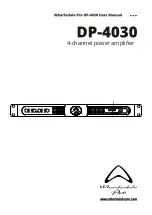
Page
27
SECTION 7.0
IEEE-488.2 INTERFACE
7.1 INTRODUCTION
The Instruments For Industry, Inc. (IFI) Amplifiers can be operated remotely from a personal computer having an
IEEE-488 interface. This interface allows the amplifier to be remotely controlled over the General Purpose Interface
Bus (GPIB) by sending commands to the amplifier. Additionally, amplifier status and forward and reverse power
readings may be read over the GPIB. All functions can be controlled by coded messages sent over the interface bus
via the 24-pin socket connector on the rear panel of the unit. IEEE-488.2 Standard is implemented, which defines
the protocols and syntax of commands. The GPIB command codes for the IFI Amplifier series are discussed on
subsequent pages and, for ease of identification; the command codes are identified within the text by bold capital
characters. For full information on the IEEE protocols and syntax the IEEE-488.2 Standard should be consulted.
7.2 REMOTE INITIALIZATION
When the amplifier receives a command over the GPIB, it automatically switches to REMOTE operation, pressing
the LOCAL key on the front panel returns the unit to normal manual local operation.
7.3 GPIB ADDRESS
The GPIB address of the amplifier is set by via the Front panel using the Control knob at the start up menu..
NOTES ON USING NATIONAL INSTRUMENTS' GPIB CONTROLLERS:
In order for the amplifier to operate correctly with a National Instruments GPIB controller card, the following must
be done: (Items 1-5 are done in the IBCONF program.)
1. Set "Terminate reads on
EOS
" to
yes
.
2. Set "Set
EOI
with
EOS
on Writes" to
yes
.
3. Set the
EOS
byte to
0Ah
(an ASCII line feed character).
4. Set "Send
EOI
at end of writes" to
yes
.
5. Set "Enable
repeat addressing
" to
yes
at the board level.
6. When sending command strings to the amplifier, a carriage return character (
0Dh
) followed by a line feed
character (
0Ah
), must always be appended to the command, otherwise the amplifier will wait indefinitely for
the
CR-LF
combination. If this happens the unit will have to be powered off and back on to reset this
condition. (The interface device will automatically assert the
EOI
line during the
LF
if items 2 - 4, above, are
set to yes in the IBCONF program.) As an example, when issuing the zero attenuation command using the
IBIC or WIBIC program, the command string would look like this: "
ZA\r\n
". (The \r is National Instruments'
notation for the carriage return, and the \n is the line feed or 'new line' character.) Notice that the commands are
upper case only.







































